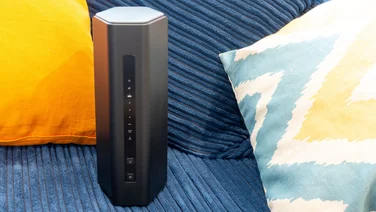To help us provide you with free impartial advice, we may earn a commission if you buy through links on our site. Learn more








- Faster than rivals
- Decent management app
- Nice design
- Dual-band radios limit bandwidth
- Limited security features
Mercusys is a new subsidiary of TP-Link, aiming to provide affordable Wi-Fi gear for home and small office setups. And the Halo H80X – the first mesh we’ve seen from the brand – absolutely nails the brief, offering swift and consistent performance for a very reasonable price.
Naturally, it’s not as fast or feature-packed as premium meshes. It doesn’t support the latest Wi-Fi 6E technology, so any 6E-compatible clients will only get regular Wi-Fi 6 speeds. It doesn’t benefit from the security features of TP-Link’s HomeShield platform, either.
Even so, for a typical household or business the Halo H80X is a perfect all-rounder. It’s cheap, compact and easy to manage and it provides all the performance and coverage you need for everyday internet and LAN access.
READ NEXT: These are the best mesh Wi-Fi systems to buy today
Mercusys Halo H80X review: What you need to know
The Halo H80X is a dual-band Wi-Fi 6 mesh. Its 5GHz radio supports connection speeds of up to 2.4Gbits/sec, with 2×2 MU-MIMO and support for ultrawide 160MHz channels. Since it lacks a separate backhaul radio, however, that bandwidth has to be shared between client connections and mesh traffic passing between the Halo units. The legacy 2.4GHz radio runs at up to 574Mbits/sec, supporting smart appliances and other devices with low bandwidth requirements.
There’s decent support for wired networking, too: each Halo unit has three gigabit Ethernet ports, so you can easily connect up to five devices (the sixth port connects to your internet modem). It’s all conveniently managed from the Mercusys mobile app and there’s also a simple web dashboard for checking the status of your network.
Mercusys Halo H80X review: Price and competition
The two-unit Halo H80X system we tested costs £162; Mercusys says this is suitable for properties of up to 460m². For bigger premises there’s a three-unit package for £250 with a claimed coverage area of up to 650m².
That’s cheap for a mesh, but there are other options at around this price point. The Huawei Mesh 3 can currently be had for £170 for three units, while a twin-pack of Xiaomi Mesh Router AX3000 units costs a mere £125. For the tightest budgets, the D-Link M15 Eagle Pro AI AX1500 has an unwieldy name but a tiny price, at £120 for three nodes. As we’ll see below, though, none of these can match the performance of the Mercusys.
If you’re willing to spend a bit more, the Huawei Mesh 7 is a possible alternative, at £230 for two units. In our tests it achieved similar speeds to the Mercusys but it does use a tri-band design, so there’s more client bandwidth to share between devices.
If you’re looking to step up to the next level of performance you’ll need to spend quite a bit more. The TP-Link Deco XE75 adds Wi-Fi 6E but it costs £343 for a two-unit pack. Or, for the fastest connection around, Netgear’s Orbi RBKE963 can’t be beaten, with 2.5Gbits/sec Ethernet as well as top-tier 6E performance. However, at £1,699 that mesh is clearly aimed at a different market to the Mercusys.
READ NEXT: These are the best mesh Wi-Fi systems to buy today
Mercusys Halo H80X review: Design and features
The plain, boxy design of the Halo H80X units might not seem all that inspired, but in a market filled with contoured towers and UFO-type discs it’s a breath of fresh air. An unobtrusive pattern of vents and grooves on the top adds a tasteful note of artistry and, since the units measure a dinky 128 x 81 x 84mm, it’s easy to situate them wherever you wish.
Each one is equipped with a functional minimum of indicators and connectors. At the front, a multicoloured LED shows the status of each unit, while at the rear, you get your three Ethernet ports and a recessed reset button. There’s no WPS button – although you can enable pairing mode in software if you wish – and no USB ports, which is the norm with mesh hardware.

The Mercusys mobile app makes setup pretty easy. There’s no QR code to scan, so you have to manually connect your phone to the H80X’s default network but, once that’s done, the system is automatically detected and configured. All you need to do is set your preferred network name and security options, and you’re good to go.
The app itself is transparently a rebranded clone of the TP-Link Deco app. I don’t mind that: it gives a clear overview of the status of your network and connected devices and offers simple settings for configuring the DHCP range, address reservation, port forwarding and so forth.

The app also includes a basic QoS tool that lets you prioritise individual devices, and a parental control module that can filter web content by category, and apply time limits and schedules to kids’ computers and tablets.
There are a few things you can’t do in the Mercusys app, however. There’s no way to split the 2.4GHz and 5GHz bands into separate networks, although you can turn them on and off individually, to force all your devices onto a single band. And you don’t get any sort of extra security features: TP-Link’s Deco meshes include the HomeShield service for network scans and active threat blocking, but there’s currently no Mercusys equivalent.

The other thing you might miss is a web-based management portal. You can bring up a web page that shows connected clients and offers a few tools such as a firmware upgrade wizard and time zone settings. Network administration, however, has to be done in the app.
Mercusys Halo H80X review: Performance
Although Mercusys advertises speeds of up to 2.4Gbits/sec, real-world data transfer rates are affected by all sorts of factors, including antenna design and transmission power, plus backhaul activity and the effects of electrical interference and signal degradation over distance.
To find out how the H80X really performs, I set up the system in my own home. The first unit was situated in the study, with one Ethernet socket connected to my internet line and another to an Asustor Drivestor 4 Pro NAS system. The second I put at the opposite end of the adjacent bedroom. I didn’t install a third station. Going by Mercusys’ recommendations, two units ought to be more than enough to fill my home.
I then connected to the Halo network from my standard test laptop: an Intel Core i5-9300H laptop fitted with an Intel AX210 Wi-Fi card. I took the laptop around various rooms in my home, copied a series of 100MB files to and from the NAS and measured average upload and download speeds. Here’s what I saw, along with some results from other mesh systems:


It’s hard to fault this performance: the Halo H80X kept up strong and terrifically consistent download speeds all through my home. It’s clearly in a league above the cheapest meshes from D-Link and Xiaomi, and it didn’t falter in the most remote locations, as the Huawei Mesh 3 did.
The Halo H80X even beat the Huawei Mesh 7 in every room. The margin wasn’t huge, but it’s still impressive that the Mercusys is able to go head to head with a mesh costing £70 more. As I’ve mentioned, the Mesh 7’s tri-band design will give it an edge when multiple devices are accessing the network simultaneously. But in everyday use you’ll probably never notice a bottleneck: with a minimum download rate of 35MB/sec, the Halo H80X is fast enough to stream ten 4K movies at once.
Unsurprisingly, the H80X wasn’t able to keep up with the 6GHz connections offered by Wi-Fi 6E meshes from TP-Link and Netgear. But, again, that won’t be a problem for most people: those systems only really make sense for power users and busy organisations that need the fastest possible connections.
The Halo H80X’s power demands are also quite modest: I measured a draw of 9.6W from the primary unit when sitting idle, rising to a maximum of 12.9W during my tests, while the secondary node idled at around 8.5W.
READ NEXT: These are the best mesh Wi-Fi systems to buy today
Mercusys Halo H80X review: Should you buy it?
The H80X isn’t the cheapest whole-home Wi-Fi solution around. The D-Link M15 costs around £40 less, and is powerful enough to serve up a stable signal to all of your devices, with a third node that gives you additional flexibility to reach tricky areas.
Nor is the H80X the fastest mesh on the market. Most Wi-Fi 6E options will deliver better download speeds, and there are a few premium Wi-Fi 6 options that outpace it too, such as the TP-Link Deco X90 and the Netgear Orbi RBK763.
If you’re shopping anywhere between those two extremes, however, it’s hard to see how you could do better than the Halo H80X. It’s cheap enough to suit almost any budget, while at the same time fast enough that there’s no need to spend more. It won’t suit the most demanding environments, but for the typical home or office it’s a perfect go-to solution and a superb introduction to the Mercusys brand.









